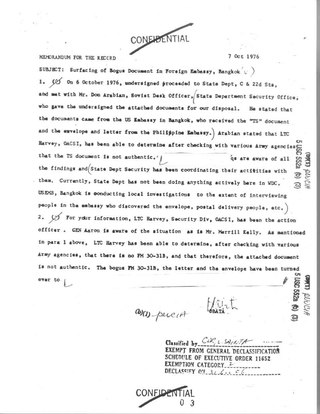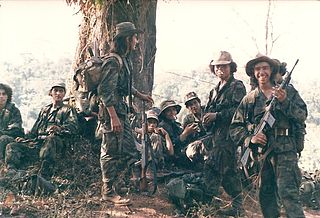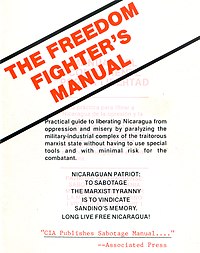
The Contras were the various U.S.-backed and funded right-wing rebel groups that were active from 1979 to 1990 in opposition to the Marxist Sandinista Junta of National Reconstruction Government in Nicaragua, which had come to power in 1979 following the Nicaraguan Revolution. Among the separate contra groups, the Nicaraguan Democratic Force (FDN) emerged as the largest by far. In 1987, virtually all Contra organizations were united, at least nominally, into the Nicaraguan Resistance.

The Republic of Nicaragua v. The United States of America (1986) was a case where the International Court of Justice (ICJ) held that the U.S. had violated international law by supporting the Contras in their rebellion against the Sandinistas and by mining Nicaragua's harbors. The case was decided in favor of Nicaragua and against the United States with the awarding of reparations to Nicaragua.

The Sandinista National Liberation Front is a left-wing political party in Nicaragua. Its members are called Sandinistas in both English and Spanish. The party is named after Augusto César Sandino, who led the Nicaraguan resistance against the United States occupation of Nicaragua in the 1930s.

The Reagan Doctrine was stated by United States President Ronald Reagan in his State of the Union address on February 6, 1985: "We must not break faith with those who are risking their lives—on every continent from Afghanistan to Nicaragua—to defy Soviet-supported aggression and secure rights which have been ours from birth." It was a strategy implemented by the Reagan Administration to overwhelm the global influence of the Soviet Union in the late Cold War. The doctrine was a centerpiece of United States foreign policy from the early 1980s until the end of the Cold War in 1991.

Psychological warfare (PSYWAR), or the basic aspects of modern psychological operations (PsyOp), have been known by many other names or terms, including Military Information Support Operations (MISO), Psy Ops, political warfare, "Hearts and Minds", and propaganda. The term is used "to denote any action which is practiced mainly by psychological methods with the aim of evoking a planned psychological reaction in other people".
The Boland Amendment is a term describing two U.S. legislative amendments between 1982 and 1984, both aimed at limiting U.S. government assistance to the Contras in Nicaragua. The first Boland Amendment was part of the House Appropriations Bill of 1982, which was attached as a rider to the Defense Appropriations Act of 1983, named for the Massachusetts Democrat, Representative Edward Boland, who authored it. The House of Representatives passed the Defense Appropriations Act 411–0 on December 8, 1982, and it was signed by President Ronald Reagan on December 21, 1982. The amendment outlawed U.S. assistance to the Contras for the purpose of overthrowing the Nicaraguan government, while allowing assistance for other purposes.

The Nicaraguan Revolution encompassed the rising opposition to the Somoza dictatorship in the 1960s and 1970s, the campaign led by the Sandinista National Liberation Front (FSLN) to oust the dictatorship in 1978–79, the subsequent efforts of the FSLN to govern Nicaragua from 1979 to 1990, and the Contra War, which was waged between the FSLN-led government of Nicaragua and the United States–backed Contras from 1981 to 1990. The revolution marked a significant period in the history of Nicaragua and revealed the country as one of the major proxy war battlegrounds of the Cold War, attracting much international attention.
Édgar Chamorro Coronel is an ousted leader of the Nicaraguan rebel Contras who later became a critic of the rebels and their Central Intelligence Agency sponsors, even cooperating with the Sandinista government in their World Court case, Nicaragua v. United States. He is a member of the prominent Chamorro family that provided five of Nicaragua's past presidents.
Psychological Operations in Guerrilla Warfare was a manual written by the Central Intelligence Agency (CIA) for the Nicaraguan Contras, who were involved in a civil war with the Nicaraguan government. It was revealed by the Associated Press on October 15, 1984. The ninety-page book of instructions focused mainly on how "Armed Propaganda Teams" could build political support in Nicaragua for the Contra cause through deceit, intimidation, and violence. The manual also discussed assassinations. The International Court of Justice case Nicaragua v. United States found that the publication of this manual had "encouraged acts ... contrary to general principles of humanitarian law." However, the CIA claimed that the purpose of the manual was to "moderate" the extreme violence already being used by the Contras.

The United States Central Intelligence Agency (CIA) has been accused of involvement in drug trafficking. Books and investigations on the subject that have received general notice include works by the historian Alfred McCoy, professor and diplomat Peter Dale Scott, journalists Gary Webb and Alexander Cockburn, and writer Larry Collins. These claims have led to investigations by the United States government, including hearings and reports by the United States House of Representatives, Senate, Department of Justice, and the CIA's Inspector General.

Enrique Bermúdez Varela, known as Comandante 380, was a Nicaraguan soldier and rebel who founded and commanded the Nicaraguan Contras. In this capacity, he became a central global figure in one of the most prominent conflicts of the Cold War.

Psychological operations (PSYOP) are operations to convey selected information and indicators to audiences to influence their motives and objective reasoning, and ultimately the behavior of governments, organizations, groups, and large foreign powers.
The main goal of the US foreign policy during the presidency of Ronald Reagan (1981–1989) was winning the Cold War and the rollback of communism—which was achieved in the Revolutions of 1989 in Eastern Europe during 1989; in the German reunification in 1990; and in the dissolution of the Soviet Union in 1991. Historians debate whom to credit, and how much. They agree that victory in the Cold War made the U.S. the world's only superpower, one with good relations with former communist regimes in Russia and Eastern Europe.

The US Army Field Manual 30-31B is Cold War-era hoax conducted by the Soviet intelligence services. It supposedly identified a "strategy of tension" involving violent attacks which are then blamed on radical left-wing groups in order to convince allied governments of the need for counter-action. It has been called the Westmoreland Field Manual because it is signed with the alleged signature of General William Westmoreland. It was labelled as supplement B, although the publicly released version of FM30-31 only has one appendix, Supplement A.

Friendly Bilateral relations now exist between Nicaragua and the United States. However, in the 19th and 20th centuries, tensions were high and American intervention was frequent. In the 1980s Due to Red Scare paranoia and an attempt to put down socialism in the region, the U.S proceeded to wage an undeclared war against the left-wing Sandinista movement by funding the Contra groups until it was defeated in the election in 1990.
The U.S. Central Intelligence Agency (CIA) has a history of interference in the government of Guatemala over the course of several decades. Guatemala is bordered by the North Pacific Ocean and the Gulf of Honduras. The four bordering countries are Mexico, El Salvador, Honduras and Belize. Due to the proximity of Guatemala to the United States, the fear of the Soviet Union creating a beachhead in Guatemala created panic in the United States government during the Cold War. The CIA undertook Operation PBSuccess to overthrow the democratically elected Jacobo Árbenz in the 1954 Guatemalan coup d'état. Carlos Castillo Armas replaced him as a military dictator. Guatemala was subsequently ruled by a series of military dictatorships for decades. Between 1962 and 1996, Left-wing guerrillas fought the U.S. backed military governments during the Guatemalan Civil War.

CIA activities in Nicaragua have been ongoing since the 1980s. The increasing influence gained by the Sandinista National Liberation Front, a left-wing and anti-imperialist political party in Nicaragua, led to a sharp decrease in Nicaragua–United States relations, particularly after the Nicaraguan Revolution. In 1981, President Ronald Reagan authorized the Central Intelligence Agency to support the Contras, a right-wing Nicaraguan political group to combat the influence held by the Sandinistas in the Nicaraguan government. Various anti-government rebels in Nicaragua were organized into the Nicaraguan Democratic Force, the first Contra group, at the behest of the CIA. The CIA also supplied the Contras with training and equipment, including materials related to torture and assassination. There have also been allegations that the CIA engaged in drug trafficking in Nicaragua.
Since the 19th century, the United States government has participated and interfered, both overtly and covertly, in the replacement of many foreign governments. In the latter half of the 19th century, the U.S. government initiated actions for regime change mainly in Latin America and the southwest Pacific, including the Spanish–American and Philippine–American wars. At the onset of the 20th century, the United States shaped or installed governments in many countries around the world, including neighbors Hawaii, Panama, Honduras, Nicaragua, Mexico, Haiti, and the Dominican Republic.
United States propaganda comics are comic books that have been published by various parts of the United States government over time as propaganda tools in various international conflicts.
The United States has at various times in recent history provided support to terrorist and paramilitary organizations around the world. It has also provided assistance to numerous authoritarian regimes that have used state terrorism as a tool of repression.













